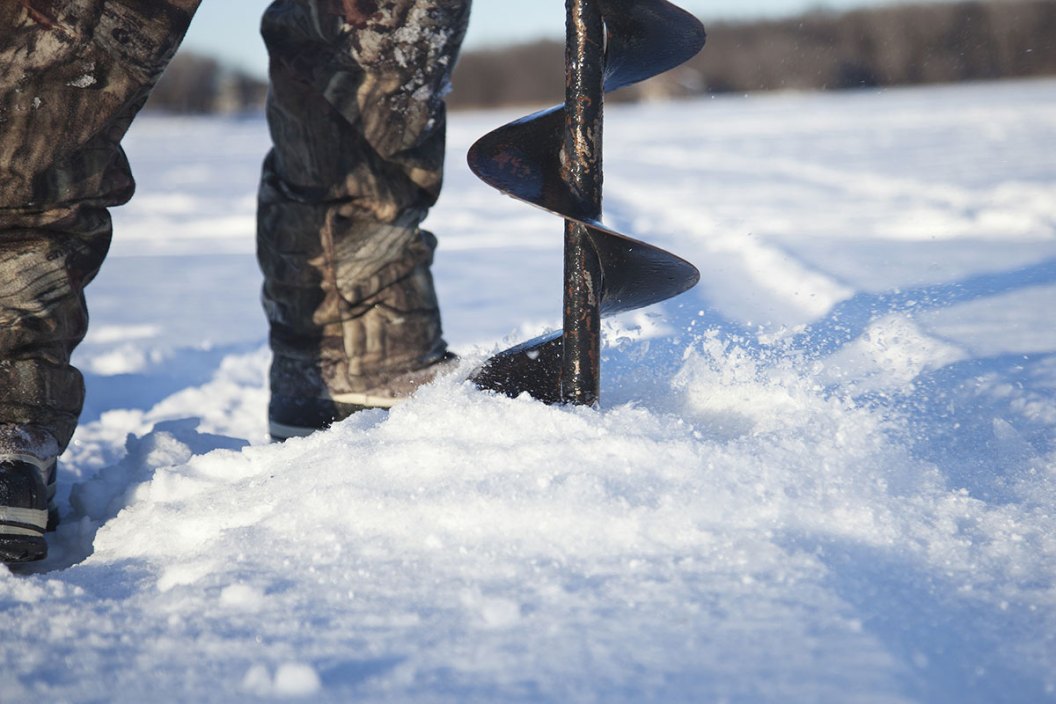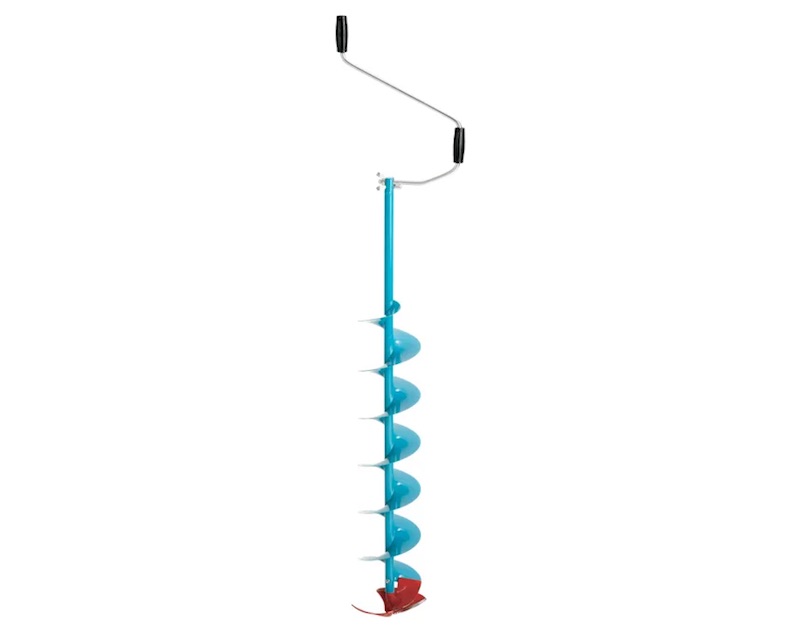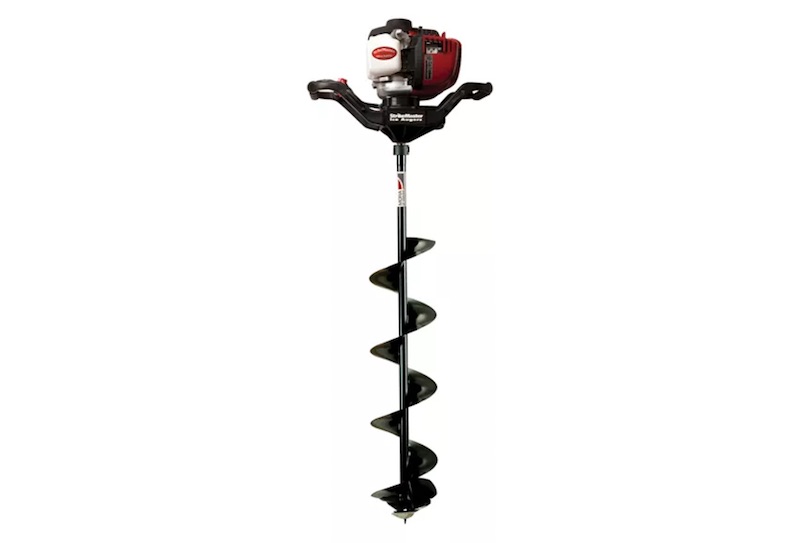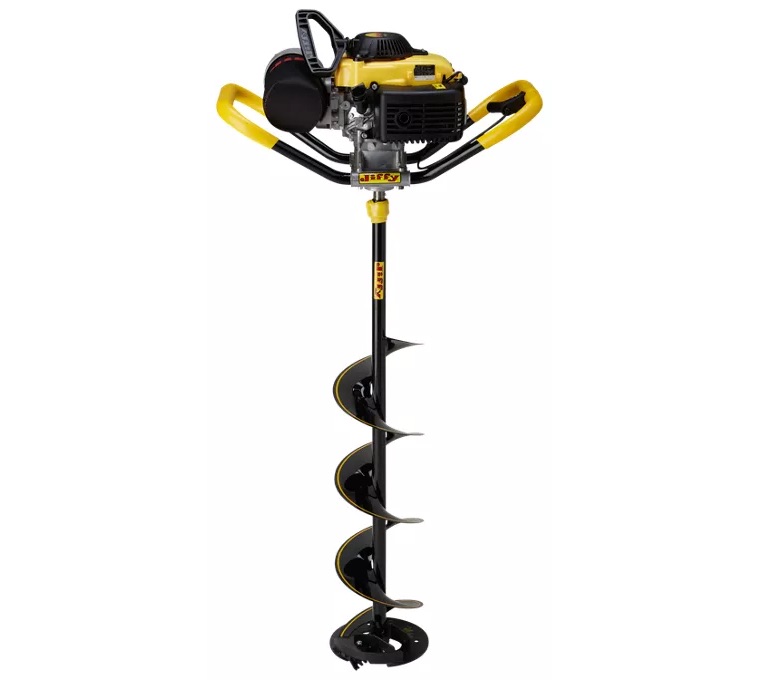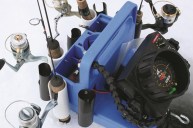The ice auger may be one of the most important ice fishing tools there are. Here's a quick review on their use and a few brands to try.
As outdoor sporting men and women, we often decry the declining amount of new hunters and fishermen out there, so even the veteran outdoorsmen in our world can surely understand why we continue to publish some simple how-to articles.
Not everyone out there has used a power ice auger, or even a hand auger, to drill a hole in the ice and drop a line in the water. Heck (and we in no way recommend this), some folks even used an old chainsaw to make a hole in the ice!
It's just that we always try to recognize the fact that a lot of folks are just starting out and would like a simple study in the basics. Here is a nice, easy review of starting, using, and taking care of an ice auger for years of ice fishing pleasure.
The Ice Auger
By definition, an ice auger is either a manual or an engine powered drill that cuts a hole through the ice.
Manual augers are used by gripping the handle and manually turning the auger in a specific direction so that the blades will cut into and though the ice. Power augers are used in the same way, the difference being that an engine-driven ice auger has much more power to drive the cutting blades, but needs a more experienced handler.
There's really no end to ways of cutting through the ice, even a breaker bar or a "spud" can do the job, depending on your fitness. We've seen people use hatchets, axes, and the afore mentioned chainsaws to perform the task, but all of these are exactly why the ice auger was invented in the first place.
Hand Auger
When using a hand auger, the number of holes you're willing or able to drill will be determined as much by the blade size (more difficult for larger blades) as it is by the ice thickness of the lake you're on. Most commonly used hand augers come in four-inch, six-inch, and eight-inch sizes and many come with adjustable handles.
Drilling with a hand auger is all about the angle; the idea is to cut as vertically as possible with no angle at all. The blade of a hand drill needs to remain as sharp as possible. Because of this, it is imperative that the user does not use the auger as a pick by pounding the ice with it.
When using a hand auger, the user will feel the drill make its way through the ice, but their job is not quite done yet. One common mistake is to raise the auger just a bit and then push it back down in the effort to chip away the last lip of ice at the bottom of the hole. This can bend the cutting blade and render your auger less than satisfactory as a cutting tool.
The better plan is to drill just a bit past finished, so that you know the cutting edge is now below the bottom of the hole and then push the lip out in a downward motion, using the non-cutting edge of the drill to finalize the hole.
One good pick for a quality hand ice auger is the Nils USA Velocity Hand Ice Auger and there are other, less expensive options, too.
Power Ice Auger
For our purposes, we'll discuss gasoline powered ice augers as they are the most powerful. These can come in a two-stroke mixed gas version, or the more environmentally savvy four-stroke engine that burns much cleaner.
The greatest reason why we created the gas powered ice auger was to be able to drill holes through the ice all day and as effortlessly as possible, making virtually an entire lake a target for the fisherman.
As with the hand auger, it is imperative to drill as vertically as possible, especially since the power of a gas operated motor can be difficult to manage for some. If the blades catch in a bad angle, it can pull the motor right out of your hands.
To avoid this, let the weight of the auger do the work for you by simply letting it cut its way through the ice without pushing down on it.
Once the cutting edge has found its way through the bottom of the ice, give it a little more throttle then lift and lower the auger in an up-and-down motion to let the auger clear the excess ice and slush out of the hole.
Make sure to have waterproof boots on, since a power auger will almost always splash water onto the ice by your feet as you finish.
Most of these augers require basic small engine maintenance, and if they aren't kept in good working order, you may end up paying the price. Make sure you learn about and properly care for your gas ice auger, and store it in a safe spot when not in use. If you're not up for small engine work of any kind, consider finding a service that is so you're guaranteed a safe and productive ice cutting mission each and every time you use it.
One great option for a gas-powered ice auger is the StrikeMaster Honda 35cc Lite Power Ice Auger followed by the Eskimo Mako Ice Auger with Quantum Blade.
Alternative Power Ice Auger
One great thing about today's technology for sportsmen is the advent and increase of environmentally friendly options. Ice augers do this in several ways including using battery operated motors, your own cordless drill, and even propane power.
Rechargeable battery operated ice drills are the epitome of the lightweight, environmentally friendly gear that simplifies the action and can be used by anyone. Cordless drill versions usually require an adapter for your drill, and generally uses a converted hand auger to do the job. One downside to the cordless drill method is that the smaller batteries of these units are usually only good for four to five holes, give or take, before it runs out.
Propane ice augers offer a very quiet-running, cleaner burning alternative to regular gas augers while still performing the task. This makes them another good choice (alongside the electric version) for using inside of an ice shanty. Propane powered ice augers are a great alternative for some, but they are a bit pricey. One good choice is the Jiffy 46 X-Treme.
Drilling Through the Choices
There are other considerations for those thinking about enhancing their ice fishing with a good quality ice auger. You'll want to think about replacement blades and their cost, the stainless steel vs. aluminum debate, necessary chargers and the amps they use, conversion kits, and so on. Many electric ice augers use lithium-ion batteries in the order of 40 volts, whereas a cordless drill is only around 9-18 volts.
For anglers everywhere considering a drill auger, there are many versions that come in combos that, while more expensive, gives the user everything that they need. Good, heavy-duty ice augers should last you for a lifetime of drilling through thick ice as long as it is taken good care of.
Ice fishing is one of our favorite ways to spend the winter months outdoors, doing the things we love to do despite how cold and snowy it may be. Remember to check on all of the local weather reports, specifically for conditions that dictate the proper safe ice thickness for your ice fishing needs.
After that, it's just a matter of getting through the ice and dropping a fishing line down the hole.
Looking for a little more or even hot lunch for your hunting blind? Follow my webpage, or on Facebook and YouTube.
NEXT: ICE FISHING GEAR: ALL YOU NEED FOR A DAY ON THE ICE
WATCH
